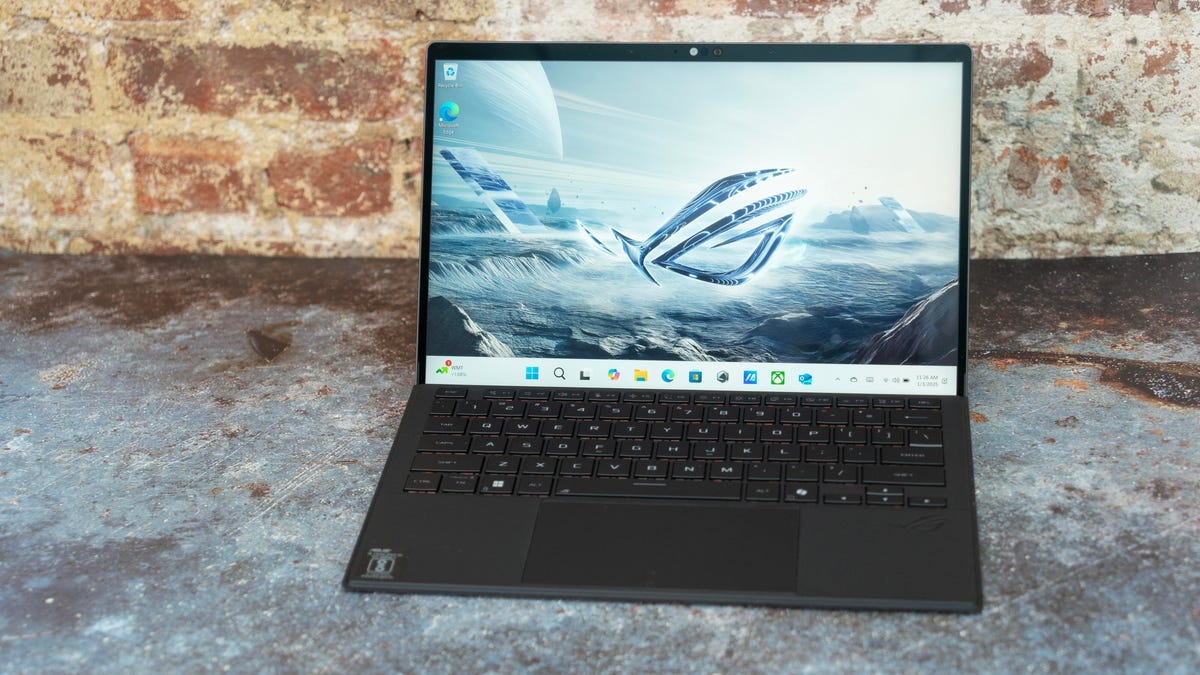Not a lot has changed between the new model announced at CES of Asus’ relatively powerful 13.4-inch tablet-with-detachable-keyboard and the ROG Flow Z13 I reviewed when it first game out, and so unsurprisingly, my opinion hasn’t changed a lot either. I like the idea and the execution, but it still feels impractical and not the first thing I think of grabbing for anything but occasional PC gaming where I want something with a bigger screen than my steam deck.
It’s still slick and generally well designed, plus Asus has improved on several aspects. For instace, the touchpad is bigger, the keyboard travel is a little deeper, the webcam is better and now supports Windows Hello, it now has quad-channel speakers, the optional XG Mobile eGPU connects Thunderbolt 5 rather than a proprietary connector and more.
The model I used incorporated the brand-new AMD Ryzen AI Max Plus 395 processor with its integrated Radeon 8060S graphics — the Z13 previously used Intel processors — and a 1600p IPS touchscreen that operates at either 60Hz or 180Hz.
Asus ROG Flow Z13 (2025, GZ302EA-XS96)
| Price as reviewed | $2,199 |
|---|---|
| Display | 13.4-inch 2,560×1,600-pixel IPS touchscreen 60Hz/180Hz 100% P3 gamut 500 nits, stylus support |
| CPU | AMD Ryzen AI Max Plus 395 |
| Memory | 32GB LPDDR5X-8000 (8x4GB soldered quad channel) |
| Graphics | Integrated Radeon 8060S |
| Storage | 1TB SSD, 1 x Micro SD |
| Ports | 2 x USB4 (2 x PD and DP 1.4), 1 x USB-A 3.2, 1 x HDMI 2.1, 1 x combo audio |
| Networking | MediaTek Wi-Fi 7 MT7925 , Bluetooth 5.4 |
| Operating system | Microsoft Windows 11 Pro 24H2 |
| Weight | 2.6 lbs/1.2kg, 3.2 lbs/1.5 kg (with keyboard) |
But like it’s predecessor, it’s a bit heavy given its size. That’s to be expected given the tank-like build, and the keyboard is on the heavy side as well. It retains a full set of connections, though, including HDMI and a micro SD slot.
The Z13 comes in two models — the $2,199 one I looked at and a cheaper $1,999 model that differs by the processor — it uses a down-level Ryzen AI Max 390 with fewer CPU and GPU cores. The upcoming versions of the refreshed XG Mobile will incorporate mobile versions of either an Nvidia GeForce RTX 5090 or 5080 GPU and has a cool translucent chassis design.
A Flow in the hand
Since the chips won’t be available until later this year (before June some time), the Z13 I used still had early-ish stage operational software and firmware, so I didn’t benchmark it or test battery life (Asus estimates it will last 10 hours), and it’s possible that some small issues I had will be fixed by the time it ships.
Asus moved the RGB-illuminated window from the previous model into a more visible position.
While I like the feel of the new keyboard — typing on it now! — the newly added RGB backlight isn’t nearly bright enough. It’s fine if you’re in a totally dark environment, but I’m sitting in the dark with Chrome open and the white screen renders the backlight useless unless you’re staring directly down at it. The keyboard is pretty stiff, but like many of these devices, it’s not comfortable to use on your lap — when the kickstand is extended, you need pretty long femurs to fit it — so its stiffness can become somewhat moot. The stiffness does help when it’s tilted on a desk, though.
Magnets hold the keyboard section to the tablet on the top and bottom long edges, whether closed or open, and they’re pretty strong. I put it down on top of a metal desk and found it surprisingly resistant to moving. It strongly latched onto my iPad when I piled them as well.
The quad speakers, with Dolby Atmos support, sound quite good. The screen seems pretty good, and Asus supplies the usual calibration profiles — I didn’t test it because the display performance can be sensitive to the BIOS and other firmware. It supports only HDR for video (Dolby Vision), not gaming, but even that’s in theory, because I couldn’t get anything to confirm DV was working. It looked fine; the P3 color space coverage helps and the tonal range looked correctly mapped, but there’s only so much you can do with a peak brightness of 500 nits, especially on a non-OLED screen.
Enlarge Image
It’s thick, but it also has a good set of connectors including a full-size HDMI port.
Casual gaming performance was mixed (sometimes dropping to below 60fps), even on power: I played Hades 2 (still in early access), Have a Nice Death, Dredge and a short stint of Hyper Light Breaker’s early access drop. But I expect that with an integrated GPU and early firmware, though those types of games aren’t very GPU heavy.
There’s a lot more to test when it’s final. For instance, the quad-channel memory and architecture of the AMD chip are supposed to deliver much better AI performance than before. I think the performance feels pretty good overall at the moment. I did encounter some instabilities, such as CapCut (which wasn’t running) crashing the system and the GPU resetting scarily (per Event Viewer).
Performance aside, though, the ROG Flow Z13 remains a fairly niche device and may appeal to people who want something more powerful and upgradeable (via the external GPU) than a Surface Pro for gaming and creating.
Read the full article here


